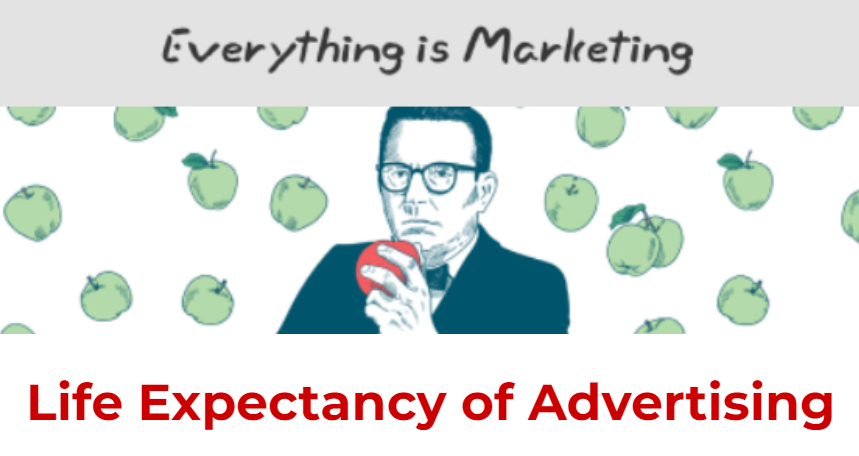
Principal – DW Creative Marketing
Dave Wieser is Principal of DW Creative Marketing, whose mission is to “Help the Doers create their legacy.” His career of 20+ years in the advertising and marketing industry has led to a wide range of experiential roles, including media selling, media buying/planning, marketing strategy, research, business intelligence and data analytics…
Life Expectancy of Advertising
One of the most common questions surrounding the modern marketer is “How do I know when it’s time to change my advertising,” or similarly, “When has a campaign run its course?”
To answer, let’s turn to Rosser Reeves, one of the original “Madmen” in its purest sense, and creator of the “unique selling proposition,” a ubiquitous concept today used by marketing strategists.
Reeves’ book, “Reality in Advertising,” is a distillation of advertising best practices from his purview of concepting some of the most iconic campaigns and copywriting in history and has been deemed as the “Rosetta Stone” for the advertising business. I’m going to share Chapter 7, The Life Expectancy of Advertising….
Excerpt from Rosser Reeve’s, Reality in Advertising, Chapter 7, The Life Expectancy of Advertising
The Red Queen, in Through the Looking Glass, was an exceedingly ill-tempered person, but perhaps she had a reason to be: she had to run at top speed to stay in the same place.
Every advertiser, whether he knows it or not, is very much like the Red Queen – for he, too, is doomed as long as he advertises, to run at top speed in an effort to stay just where he was months, or even years ago.
Many advertisers, in fact, are in even worse shape. For as we have seen from some of our penetration case histories, some advertisers may not stay in the same place even when they do run at top speed. The public has an appallingly ephemeral memory; penetration, bought and paid for with millions and millions of dollars, can drift away like morning fog; and a good many of the realities of advertising stem from this fact.
As Arthur Nielsen puts it: “We spend our lives trying to fill a leaky bucket.”
Let me tell a story:
A few years ago, we performed an experiment to determine the life expectancy of penetration. How long does a person remember a campaign, once he has it in his head? When does some other advertising crowd it out?
We found out the exact number of people who remembered the advertising of a big brand which we handle. 50% knew it and 50% did not. We kept the names and addresses of these people (something not normally done as a matter of course), and six months later went back to the same people.
Keep in mind that the same campaign was still running.
We were astonished to discover that half of the people who had known our story had now forgotten it; and half of those who had not known it could now describe it. If you wanted a picture of the “Passing Parade,” in very simple but depressing form, here it is:

You will see, from the bar on the left, that 50% of the people knew our story when this survey was made. But not glance at the bar on the right. Six months later, 50% still know the story – but half of the old group has forgotten it, and a new group has taken their place.
Again, we must caution you that this is not an isolated experiment. It is not true of just one brand. It is true of all brand; and what is more, there is an important corollary:
The advertiser given in the example above managed to maintain the same percentage of penetration by continuing the same story and by continuing the same pressure of advertising dollars. Had he changed his story, or lowered the pressure of his advertising dollars, he would have witnessed a sudden and very painful drop – for either one, or both, of these reasons.
Recently, we watched the drama of an advertiser who had 65% penetration on a powerful, sales-winning theme. Then he changed campaigns. In eighteen months, his hard-won 65% penetration had dropped to 2.2% – in other words, almost vanished entirely.
As you will see later, this constant shifting of penetration has enormous implications in the reality of advertising. It is going to force us to do a good many things we might not otherwise do. We must keep in mind that $43 billion a year is being spent for penetration. This is the rather staggering sum of $117 million a day, spent in a desperate attempt to buy brands a bit of space in the memory box of the consumer. He is beleaguered consumer, a confused consumer, battered by television, assailed by print, assaulted by radio, bewildered by posters. It is very difficult to get him to remember, and he is very prone indeed, to forget.
[Sidenote: this was in 1960; US Advertising spending in 2021 was almost $300 billion or $820 million a day! I’m sure he would’ve added “and ravaged to the brink of insanity with social media…”]
Penetration is volatile. Like vapor, it can melt into thin air.
Like the mercury in a barometer, penetration is supported by pressure – the pressure of the same story, and of advertising dollars. When the pressure falls, or the story changes, the penetration barometer falls; and your chance to exercise your usage pull comes down just as fast.
What do you think? Do you agree? Business leaders often get very anxious and bored with their current advertising. I am not suggesting that we cannot entertain change. However, we need to understand that with change, comes inevitable repercussions, whether we like it or not.
